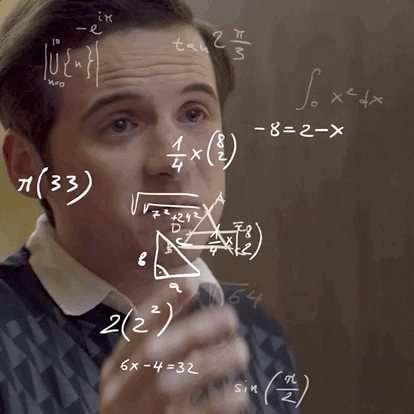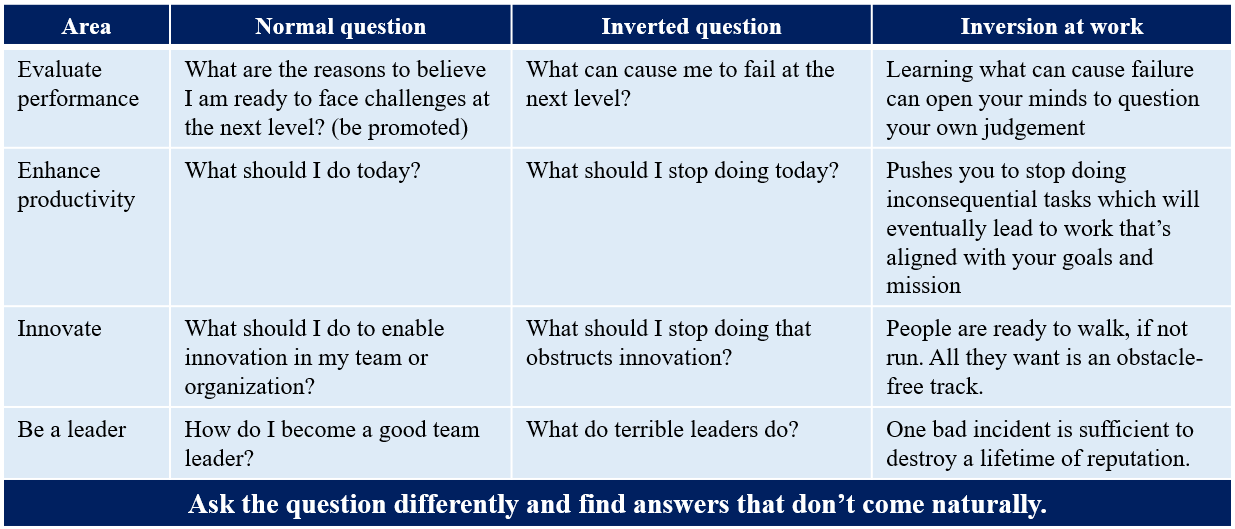Hi,
Hope you are enjoying your day!
I have so many decisions to make: How do I fail? How do I make the life of my customers difficult? How do I die? No, not a typo. No! I am not a sadist! (not yet) Don’t judge, please. To my mind I am making complete sense, hopefully, at the end of this, it makes sense to you too. It’s just all inverted. Let’s dive deeper…
How to solve equations?
(Hint: The first step is not to cry and second, um… haven’t figured out yet, still coping with the first one)
Fortunately, mental models don’t require you to learn cool math stuff. You just need to figure out the best of what other people have figured out.
Storytime: Once upon a time, there was a guy called Carl Gustav Jacob Jacobi. He was a smart mathematician who made several contributions to science. He is said to have told his students, one should: ‘man muss immer umkehren’ (translated as 'Invert, always invert'), reflecting his belief that inverting known results can open up new fields for research. So…
What is Inversion?
Inversion is basically reversing the situation. It is thinking about what we don’t want. It’s very easy to understand, but equally challenging to implement in a real-life situation. No, it is not difficult, it is just counter-intuitive. It goes against our default biases/ assumptions.
When challenged with a problem, we think of: How can I succeed in this project? What strategy or process will help me get where I want to be? Let me make a SWOT analysis and try to understand the problem. This is thinking forward. Nothing wrong with it. But,

So, let’s say you are back to school (though, I hope you don’t think you need to be there to learn new stuff) and if you wanted to complete a particular subject in say two days. It has 15 modules. If you complete 1 module in an hour and study for 8 hours each day (not sure what you’d be doing the other 16, life is constant learning), you will be able to easily complete the subject by the next day with an extra buffer hour (maybe, to revise… I have still not been able to revise my algebra, not sure about you). We all have been through this process. Let me break it to you, no, this is not inversion. This is thinking backward. As opposed to thinking forward, for thinking backward you begin with the end in mind.
For both thinking forward and backward your goal is the same. You just approach it from a different direction. So this is not Inversion.
So what exactly is Inversion?
For inversion, your goal is the opposite of what you want to achieve (it is wrong by definition, how counter-intuitive!).
If you want to achieve A. Your goal becomes of not achieving A. It becomes: What will I have to do to fail at A? Once you identify the most important thing to fail at A, all you need to do is avoid doing that most important thing.
To know your Enemy, you must become your Enemy.
~ Sun Tzu
Let’s explore this with some examples:
Think success, Nah, Think failure!
Let’s say, you are an investment manager, and you want to ensure that your investors get the best returns. How do you go about it?
Let’s invert: I want my investors to lose money. I want to give them a slow death. How do I do it?
Mr. John Bogle had the same problem. He arrived at the conclusion that the best way in which he can harm his investors is by charging them extremely high management fees on their investments every year on a regular basis.
(FYI: Hedge funds, private equity, and venture capital - all follow a 2% + 20% system of management fees. There’s a case for a Boglehead to disrupt this industry.)
So he decided to (a) charge the lowest management fees in the industry, and (b) ensure that all profits of fund management go back to the investors in the fund. Thus, Vanguard was born in 1975. Today it manages assets worth USD 7.3 trillion, the second-largest in the world, only after BlackRock. Such is the power of inversion! Think how to fail and thou shall succeed.
Make life worse
We may have heard the adage: Customer is the king.
Well, this is a class of inversion. Nothing makes sense here. I want to harm the king so that I am held guilty. If I am designing an e-commerce platform, how do I ensure that I make the life of my customer hell?
I will ensure that it is difficult for the customer to find what he wants. The moment he reaches the payment page, the website crashes, and he has to start all over again. If and when he is able to order and make payment, I will ensure the product doesn’t deliver to him for months, if not years. I will have to ensure that the product is damaged, with no customer service to help the customer. I will want the overall experience to be so bitter that he seeks revenge - in red blood. Okay, maybe that’s a little more, but, I guess you get the hang of it,
Now, all I have to do to run a successful e-commerce company is to prevent this from happening. I ensure my website has a clean and easy-to-use UI. The payment gateway has one of the best uptimes. For the unfortunate scenario where things go bad, I have a digital ‘Cart’ or ‘Shopping Bag’ where the items which the customer wanted to buy are stored. I will ensure timely (same-day?) delivery. I will ensure prompt customer service.
If I use this process consistently, over a long period of time, I am sure to succeed. Ask Bezos.
Thinking in reverse does help you think clearly and quickly and avoid stupidity.
If you consistently avoid stupidity, you are already in the top quartile
Dealing with unknowns
Dealing with unknowns is difficult. But inversion just helps you make a decision. It may not always be correct, but it does help you sail through. If you are dealing with an unknown, something you have not done before, one must do basic due diligence (ordinary care). Transacting on a new website? Buying a new gadget? Think that you do want to be cheated. Now, what would you have to do to be cheated? Now, avoid doing that. As simple as that. You will be much better off than not.
Let’s expand this to one of the trickiest of topics. Death.
There is only one God. And his name is Death. And there is only thing we say to Death. Not Today.
~ Game of Thrones (Syrio Forel tells Arya Stark)
And, for those who love Munger:
All I want to know is where I’m going to die, so I’ll never go there.
~ Charlie Munger
So if you want to avoid death. Invert! Think of I want to die. How do I do it? Eat poorly, do not exercise, fight with a person having a gun, jump of a cliff, etc. Now you know what to avoid.
But, hey, not everything is in your control. You can’t control aging (yet). You can’t control how well the car behind you will drive. Likewise, you can’t control how would an algorithm of the self-driving car will choose in case of the trolley problem. But, no need to worry about things not in your control.
Avoiding stupidity is easier (and more effective) than seeking brilliance.
Some more examples to get the flow:
This should help you ask the right questions.
Summary:
Instead of aiming directly for your goal, think deeply about what you want to avoid and then see what options are left.
Inversion helps improve understanding of the problem, by forcing you to do the necessary work. To have an opinion, you are forced to consider different perspectives.
Inversion helps you:
Envision potential roadblocks
Understand and prepare for future risks
Expands your thinking
Innovate
Understand and avoid patterns of failure
Brace uncertainty
Hope now questions like: How do I fail? How do I make the life of my customers difficult? How do I die? Etc. make perfect sense to you.
In this post, we have expanded Inversion to business use cases such as industry disruption, innovation, customer experiences, and also Death, amongst a host of other areas. Like all mental models, we can expand this concept even further to other areas as well.
Can you expand this to having good familial relationships or maybe, becoming rich?
Also, Inversion does show up on the Balance Sheets of successful companies. The positive retained earnings that you see in the balance sheet, yeah, that’s because someone out there consciously or unconsciously applied Inversion to achieve that profit.
In case, you find that the retained earnings are negative/ not up to the mark, go ahead, share this article with them. Don’t forget to ask them to subscribe to us.
This is a completely free post with the only expectation of receiving your thoughts, ideas, and feedback on what I write (and what I missed!). You can send it by way of commenting or replying to this email.
Bonus:
Watch the below 4-minute video on Inversion, by the man himself, Charlie Munger:
Explore with your minds!
Best,
Naitik Shah



with Problems:
A. You think backward to identify the causes (this can help you prevent similar problems going forward.
B. You think forward to identify the consequences (this can help you prepare for what is yet to come)
C. But, to avoid problems altogether, you need to go reverse. So inversion is the way to go!
Thank you for adding this to my perspective! Really liked it :))